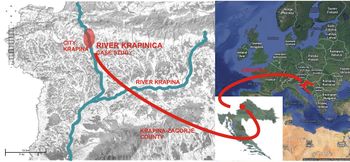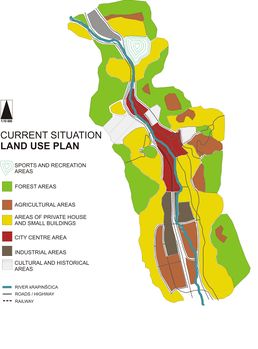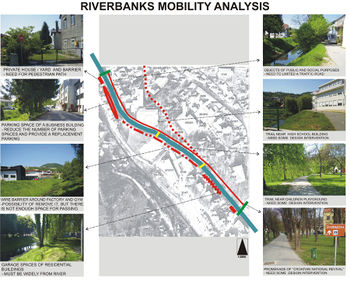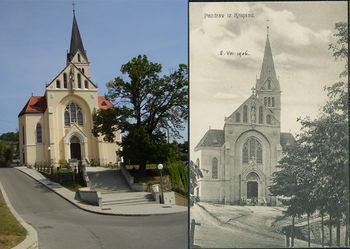Green Infrastructure 2014 Group N - Case Study 3
---> back to group page working group N
'''== Kapinica River, Krapina city, Croatia =='''
| Name | Kapinica River | |
| Country | Croatia | |
| City | Krapina | |
| Authors | Mateja Leljak | |
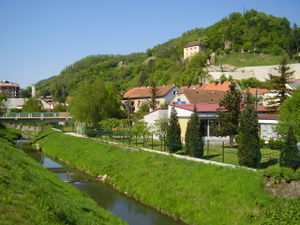
| ||
|
| ||
Interesting fact about Krapinica river
Ignoring the natural values, visual quality and importance of the Krapinica river, led to devastation of river banks using concrete and construction on the very edge of the river. Physical changes in river flow and changes of speed water runoff are natural features of the ecosystem and the environment. So far, green river system of Krapinica river has been inadequately used, with impaired identity and visual quality. Existing green open areas in the Krapina city and their (dis)connection with the river Krapinica are becoming questionable.
My perspective
This academic year I will get my Master’s degree in Landscape architecture at Department of Ornamental Plants, Landscape Architecture and Garden Art at University of Zagreb. I decided to engage in a new and useful work that could be of importance to mycolleagues in a similar and/or same profession and could also be useful for my hometown. That is why I am writing my thesis on Green Infrastructure in Krapina city. The bigger problem about green open spaces in rural/urban environment is how local authorities are trying to do the "right thing" with it, so I think this might be a good basis for future work on GI of Krapina City.
Landscape and/or urban context of Krapina-Zagorje County and Krapina city
KRAPINA-ZAGORJE COUNTRY
Krapina-Zagorje County is a county in northern Croatia. It encompasses most of the historic region called Hrvatsko Zagorje. The Krapina-Zagorje County is a candidate for being the most idyllic county in Croatia: the many villages and small towns spread out across the hillsides are perfect for agriculture (vineyards in particular) and summer houses.
The Krapina-Zagorje County borders on the Varaždin County in the northwest, Zagreb County in the southwest and southeast, and the city of Zagreb in the south.
County seat of Krapina-Zagorje County: KRAPINA
Area: 1,229 km2 (475 sq mi)
Population (2011) : 132,892 / 110/km2 (280/sq mi)
Area code: 049
ISO 3166 code: HR-02
KRAPINA – the centre of Krapina-Zagorje County
Krapina is cultural, political and administrative centre of Krapina-Zagorje County and it is the largest region in Hrvatsko zagorje. It is located approximately 55 km (34 mi) from the Croatian capital city Zagreb. This is an area of many hills, rivers, creeks and lakes through many valleys.
Area: City_47.53 km2 (18.35 sq mi) // Elevation_203 m (666 ft)
Population (2011): City_12,479 // Densty_260/km2 (680/sq mi) / Urban_4,482
History
Perhaps the most astonishing landmark of the area is the excavation site of a 125,000 year old Neanderthal man in caves near the central town. The fact that Krapina is the political centre of the county has historical roots. Krapina County (comitatus crappinensis) was mentioned as early as 1222 in the 1222 charter of Duke Béla where prince Petar of Krapina was named the head of the Croatian noble parish (Petar “comes de Crapuna”). King Sigismund of Croatia and Hungary, who owned an estate in Krapina (Castrum Carpone), awarded the mayor of the town of Krapina the title of the Great Count of Zagorje County in 1399. During the administration of ban Ivan Drašković, five sessions of the Croatian Parliament were held in Krapina at the turn of the 17th century. Ante Starčević, the Father of the Nation, and bishop Juraj Strossmayer, signed political agreements in Krapina that defended Croatia’s interests.
Culture
Krapina is a home to yearly Festival kajkavske popevke (The festival of kajkavian song) sung in the local Kajkavian dialect. At the site where the Neanderthals remains were discovered there is now a state of the art Neanderthal museum which also includes an extensive segment on evolution, making it one of the most interesting evolutionary museums in Europe. It is surrounded by a park with many statues of Neanderthals and their game, a bear, a moose and a beaver set in the actual locations. There is also a nearby municipality of Krapinske Toplice (Krapina spa) with numerous thermal springs and spa tourist infrastructure. Krapina is also the birthplace of the linguist and language reformer Ljudevit Gaj. His home is now a museum where visitors can learn about his life and work.
Industry
The main industrial branches are textiles and garments, production of housing containers and potassium stoves, Styrofoam, wiring supplies from plastic material, and construction industry specialized in the restoration of classical buildings with a large share of a craftsman works. A new business and trade centre will also be opening soon in Krapina; the town offers not only trade but also intellectual services, including marketing and project management firms, legal and financial services, medical and dental services, as well as many personal services such as hairdressing, pedicures, beauty salons, photography, photocopying shops, laundry services etc.
- Illustrations: maps; sketches; short descriptive analyses
- Illustrations
Analytical drawings
After reviewing the wide and narrow urban context of the Krapina - Zagorje County and the town of Krapina, the situation a long the Krapina river was also analyzed.
The active and passive traffic of Krapina city was also analyzed to better grasp the impacts of roads on the river.
In addition to traffic, views of the city (perspectives viewpoints) are another important element to analyze. This analysis gives knowledge of certainvist as that can be prioritized and some that are detected to be unattractive.
The analysis of the mobility along the Krapivnica riverside indicates some urban problems that occurred by the edge of the river.
- Analytical Drawings
- Your drawing.jpg
your drawing
Green Infrastructure benefits for this site
Green infrastructure’s benefits can generally be classified into three large categories: social benefits, environmental benefits and economical benefits.
1.Social benefits: Krapinica river passes through urban and rural areas of Krapina city administrative boundaries. In the city center, which has an urban character, there are different urban elements and structures that have important cultural purposes. If those areas would get associated with the river, they would have more of a socialcomponent and importance and the social life could develop on entire river and not just in some small parts.
2.Environmental benefits: Krapinica river does not abound with fresh water because of a profound and extending riverbed which speeds up water flow through the city. During high rainfall season, it affects the groundwater and river water table. Restoring the river in more natural movement through the Krapina town would lead to groundwater levels maintained, rainwater retention, stormwater retained, stream flows stabilized.
3.Economical benefits: Connecting the Krapina city and the wider surrounding area (with green corridors, biking and hiking trails) will lead to greater development of tourism. Combining the surrounding areas with facilities along on the Krapinica river can result in quality of place, recreation and leisure, tourism, land and biodiversity.
Potential for multifunctionality
GI in Krapina city has a multi functional aspects of three main benefits: social, environment and economical. Typical multifunctional GI area in Krapina city has to be able to combine farming and forestry (from rural areas near by), housing ( in city and local area), tourism and recreational activities from rural area to center city areas and in city areas).
This multifunctional system has to connect local (rural) area near Krapina city with city and connect with river Krapinica. There is a strong relationship between city and local (rural) places in this multifunctional system. This will pride local economy, environment and people to connect with city for better prosperity and coexistence between rural and urban area.
Projective drawings
- Changes that can be done in near future (in 1-2 years) are focused on Krapina city area. They can start with Krapina river, which should be returned into its more natural state then it is now. It can also include pedestrian and cycle routes, private and urban garden near river, school and children playgrounds, main square and streets.
- In the period of 10 to 15 years GI is supposed to connect river Krapinica with other green areas in Krapina city and connect Krapina city with local rural areas and smaller towns near by. Agricultural land in peri-urban part of Krapina city has a huge value for people who live there (shipping food to local market). That also applies for rural areas outside the Krapina city administrative boundaries. Production from the land affects local and regional tourism, human health, land and biodiversity.
- Projective Drawings
- Yourdrawing.jpg
projective drawing
- Yourdrawing.jpg
projective drawing
- Yourdrawing.jpg
projective drawing
Summary and conclusion
The river is an important spatial element; it play san important role in the landscape, especially in urban areas because it is the back bone of the city. It improves the microclimate and attracts beneficiaries and users. Through a historical overview we can clearly perceive its importance and role, sometimes defensive, religious and structural but more recently its cultural, social and ecological function. Krapinčica river makes an important green system of the Krapina city. It is necessary to preserve it and enrichment with different contents and structures to give users new activities with a strong focus on the benefits (social, economical and ecological) provided by green infrastructure.
Image Gallery
Photo gallery shows new and old photographs and postcards of Krapina city. On the old postcards we can see the quantity and distribution of surrounding green areas in town and the way open space is being used. On today's photographs the quantity of green open areas is smaller and not used to its potential compared to the past use.
- Image Gallery
References
KRAPINA CITY
http://tzg-krapina.hr/en/en/information
http://www.croatiameetings.com/destinations/krapina/23/
KRANEAMUS KRAPINA NEANDERTHAL MUSEUM
About categories: You can add more categories with this tag: "", add your categories
